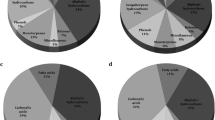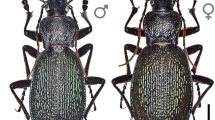Abstract
The large paired reservoirs of the pygidial gland of Azteca nr. bicolor and A. chartifex represents the largest exocrine structure in the abdomen. The glands produce a secretion with a strong smell, which the ants release when they are disturbed. Analyses of the secretions by gas chromatography–mass spectrometry (GC-MS) revealed a mixture of iridoids and ketones. A. nr. bicolor contains 2-heptanone (8%) and a mixture of three iridodial isomers, with trans-trans-iridodial as the major component (32%). A. chartifex contains 6-methyl-5-hepten-2-one (13%) and the three isomeric iridodials with cis-trans-iridodial as the principal component (32%).
Similar content being viewed by others
REFERENCES
Attygalle, A. B., and Morgan, E. D. 1984. Chemicals from the glands of ants. Chem. Soc. Rev. 13:245–278.
Billen, J. 1986. Morphology and ultrastructure of the abdominal glands in dolichorine ants. Insectes Soc. 33:278–295.
Clark, K. J., Fray, G. I., Jaeger, R. H., and Robinson, R. 1959. Synthesis of D-and L-isoiridomyrmecin and related compounds Tetrahedron 6:217.
Dazzini Valcurone, M., and Fanfani, A. 1982. Nuove formazione glandolari del gastro in Dolichoderus (Hypoclinea) doriae Em. Formicidae, Dolichoderinae). Pubbl. 1st. Entomol. Agric. Univ. Pavia 19:1–18.
Harada, A. Y. 1982. Contribuição ao conhecimento do gênero Azteca Forel e aspectos da interação com plantas do gênero Cecropia Loefling. Tese de Mestrado, INPA/FUA, Manaus, 181 pp.
Harada, A. Y., and Benson, W. W. 1988. Espécies de Azteca (Hymenoptera: Formicidae) especializadas em Cecropia spp. (Moraceae): distribuição geográfica e considerações ecológicas. Rev. Bras. Entomol. 32:423–435.
Harborne, J. B. 1993. Introduction to Ecological Biochemistry, 4th ed. Academic Press, London, 318 pp.
HÖlldobler, B., and Wilson, E. O. 1990. The Ants. Springer-Verlag, Berlin, 732 pp.
Moore, B. P., and Brown, W. V. 1979. Chemical composition of the defensive secretion in Dyschirius bonelii (Coleoptera: Carabidae: Scaratinae) and its taxonomic significance. J. Aust. Entomol. Soc. 18:123–125.
Morgan, E. D. 1990. Preparation of small-scale samples from insects for chromatography. Anal. Chim. Acta 236:227–235.
Morgan, E. D., and Wadhams, L. J. 1972. Gas chromatography of volatile compounds in small samples of biological materials. J. Chromatogr. Sci. 10:528–529.
Noirot, C., and Quennedey, A. 1974. Fine structure of insect epidermal glands. Annu. Rev. Entomol. 19:61–80.
Oldham, N. J. 1994. Chemical studies on exocrine gland secretions and pheromones of some social insects. PhD thesis. Keele University, Keele, UK, 201 pp.
Overall, W. L., and Posey, D. A. 1990. Uso de formigas Azteca spp. para controle biológico de pragas agrícolas entre os indios kayapó do Brasil. Proceedings of the 1th International Congress of Ethnobiology, Belém, Brazil.
Pavan, M., and Ronchetti, G. 1955. Studi sulla morfologia esterna e anatomia dell'operaia di Iridomyrmex humilis Mayr e ricerche chimiche e biologiche sulla iridomirmecina. Atti Soc. Ital. Sci. Nat. 94:379–477.
Trave, R., and Pavan, M. 1956. Veleni degli insetti: Principi estratti dalla formica Tapinoma nigerrimum Nyl. Chim. Ind. 38:1015–1019.
Wallbank, B. F., and Waterhouse, D. F. 1970. The defensive secretions of Polyzosteria and related cockroaches. J. Insect Physiol. 16:2081–2096.
Wheeler, J. W., Evans, S. L., Blum, M. S., and Torgerson, R. L. 1975. Cyclopentyl ketones: Identification and function in Azteca ants. Science 187:254.
Wilson, E. O., and Pavan, M. 1959. Glandular sources and specificity of some chemical releasers of social behavior in dolichoderine ants. Psyche 66:70–76.
Author information
Authors and Affiliations
Rights and permissions
About this article
Cite this article
Do Nascimento, R.R., Billen, J., Sant'ana, A.E.G. et al. Pygidial Gland of Azteca NR. bicolor AND Azteca chartifex: Morphology and Chemical Identification of Volatile Components. J Chem Ecol 24, 1629–1637 (1998). https://doi.org/10.1023/A:1020864427854
Issue Date:
DOI: https://doi.org/10.1023/A:1020864427854




